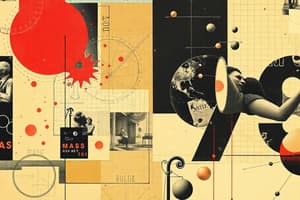Podcast
Questions and Answers
What is the atomic number?
What is the atomic number?
The number of protons in the nucleus of the atom.
What is atomic weight?
What is atomic weight?
The mass of the protons and neutrons in the atom.
How is atomic weight determined?
How is atomic weight determined?
Based on the number of neutrons the majority of the element's atoms have.
What are isotopes?
What are isotopes?
The number of protons is equal to the _____ number.
The number of protons is equal to the _____ number.
The number of neutrons can be calculated by the formula: Atomic Mass - Atomic _____ .
The number of neutrons can be calculated by the formula: Atomic Mass - Atomic _____ .
What are electron energy levels?
What are electron energy levels?
What does each period on the periodic table represent?
What does each period on the periodic table represent?
How many electrons can the first three energy levels hold?
How many electrons can the first three energy levels hold?
What is an ion?
What is an ion?
What are valence electrons?
What are valence electrons?
What do Lewis Dot Diagrams represent?
What do Lewis Dot Diagrams represent?
Who created the periodic table?
Who created the periodic table?
What are periods on the periodic table?
What are periods on the periodic table?
What are groups in the periodic table?
What are groups in the periodic table?
What is the Standard Model?
What is the Standard Model?
Flashcards are hidden until you start studying
Study Notes
Atomic Structure
- Atomic number: Represents the number of protons in an atom's nucleus.
- Atomic weight: Calculated by combining the mass of protons and neutrons (approximately 1 amu each).
- Atomic mass: Influenced by the predominant number of neutrons present in an element's atoms.
- Isotopes: Variants of elements with the same atomic number but different neutron counts, resulting in different atomic masses.
Particle Calculations
- Protons: Quantity equals the atomic number.
- Electrons: Typically equal to the number of protons, hence the atomic number.
- Neutrons: Found by subtracting the atomic number from the atomic mass.
Electron Configuration
- Energy levels: Regions around the nucleus where electrons reside; each level has a specific capacity for electron storage.
- Orbitals: Subdivisions of energy levels, with each holding a maximum of two electrons.
- Electrons per energy level:
- 1st level holds 2 electrons
- 2nd level holds 8 electrons
- 3rd level also holds 8 electrons.
Ion Formation
- Ions: Formed when atoms gain or lose electrons, resulting in charged species.
- Positive ions: Created when an atom loses one or more electrons.
- Negative ions: Result when an atom gains one or more electrons.
Valence Electrons and Bonding
- Valence electrons: Electrons located in the outermost energy level, crucial for chemical bonding.
- Lewis Dot Diagrams: Visual representation of an atom's valence electrons to illustrate bonding potential.
Historical Context of the Periodic Table
- Dmitri Mendeleev: Pioneer Russian chemist who developed the periodic table with 56 known elements; arranged them by physical properties and predicted undiscovered elements' existence.
Periods and Groups
- Periods: Horizontal rows in the periodic table indicating elements with increasing energy levels; each successive period adds a new energy level.
- Groups: Vertical columns of elements with similar chemical and physical properties; elements in the same group have the same number of valence electrons, which increases sequentially from left to right.
Fundamental Composition of Atoms
- Standard Model: Atoms consist of 61 elementary particles, forming the basis for understanding atomic structure and interactions.
Studying That Suits You
Use AI to generate personalized quizzes and flashcards to suit your learning preferences.




